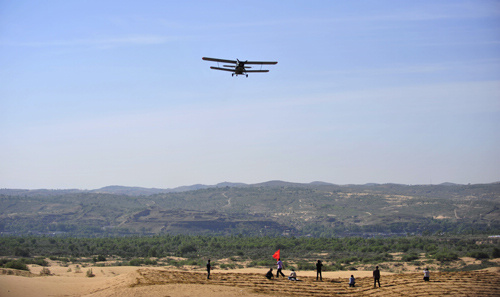|
 |
|
GREEN GREAT WALL: An aircraft spreading tree seeds on the southern edge of the Maowusu Desert last June (CHEN TUANJIE) |
"Planting trees is only the beginning. A fundamental way to protect desert ecosystems is to perform maintenance on the trees every three or four years to keep them alive, otherwise, the efforts will be in vain," Li said. Green areas covered by trees a decade ago might degrade to their original state.
The Maowusu Desert, located between Yulin City in central China's Shaanxi Province and Ordos City in Inner Mongolia, is one of the four largest deserts in China. Uxin Banner in southern Inner Mongolia is located in the center of Maowusu. Covering an area of 11,645 square km, Uxin is a region where 94.8 percent of land is affected by desertification. Combating soil erosion is a cruel fact of life the banner must face.
The Maowusu Biomass Thermoelectric Co. is situated in Uxin, where Li has worked for nine years.
The company operates a thermoelectric power plant using shrub trimmings as fuel. While harvesting energy from the combustion of biomass, the power plant also sequesters carbon dioxide emissions to cultivate spirulina, a type of algae that can be used as a nutritional supplement.
In this way, a unique industrialized mode of fighting desertification has taken shape, producing environmentally friendly electricity, improve people's livelihoods and reducing emissions. This circular industrial system recycles carbon and uses sand to fight sand.
"The core to utilize new energy in desert area is to control desertification," said Li. The shrubs develop usable bush wood and require pruning in three to five years in order to flourish.
"This is a solution to combat desertification, develop biomass energy and materialize low-carbon production and emission reduction," Li told Beijing Review.
Maowusu's thermoelectric power project, put into operation in November 2008, has invested an average of 50 million yuan ($7.9 million) annually in late shrub maintenance, including an industrialized chain of planting, nursing, cutting, transporting and processing. The project created about 8,000 jobs, and increased the annual incomes of local herdsmen by more than 70 million yuan ($11 million).
Su Zonghai, Undersecretary General of the China Green Carbon Foundation, analyzed the project's performance in the Beijing-based Forestry Economics magazine.
"'Three-carbon economy' [carbon absorption, carbon emission reduction and carbon sequestration], an industrialized mode to combat desertification, is not only a typical recycling economic mode, but also a new eco-economic development mode integrating well with forestry of carbon sinks, low-carbon economy, and ecological construction.
The project, with a total investment of 500 million yuan ($79 million), has thus far: treated 24,000 hectares of desert; built a first-phase spirulin-production item by using sequestered carbon dioxide emitted during electricity generation; and produced over 240 million kilowatt-hours of electricity with the 30,000-kilowatts thermoelectric plant. The company realized a production chain of planting trees to fight desertification and absorb carbon dioxide. Trimmings from those trees fuel the power plant, which traps carbon dioxide emissions which are in turn sequestered within the spirulin-producing algae.
The Maowusu project is considered an industry exploring the improvement of human environment, and a model item providing healthy food. The project exposed desert value as a resource, integrated human living environment with human health, and achieved sustainable development through an industrialized recycling chain process.
Luc Gnacadja, Executive Secretary of UN Convention to Combat Desertification, spoke highly of the Maowusu project at the symposium. He hoped the approach could be introduced as a good model for African and other developing countries and become a best practice globally to fight desertification.
(Reporting from New York City)
Email us at: wei298@hotmail.com | 